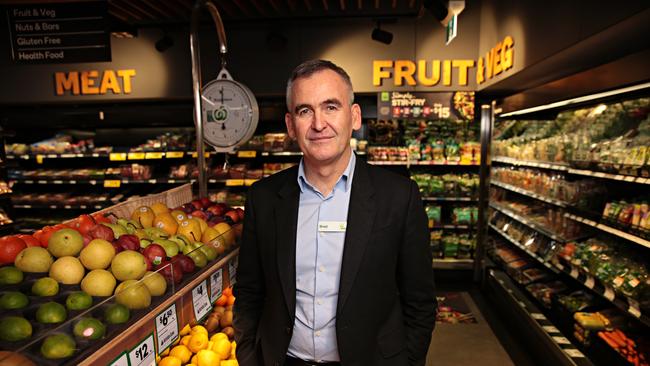Woolworths CEO Brad Banducci backs wages increase in-line with underlying inflation
The retailer is seeing price increases across fresh produce, led by red meat and vegetables, and backs a wage increase for its 180,000 staff to fight inflationary pressures.

Woolworths chief executive Brad Banducci, whose retail giant employs around 180,000 workers and is the biggest private sector employer in Australia, said it’s time for a wages hike so his staff can keep pace with the rising cost of living and that it is supporting the retail industry’s pitch for a boost in retail staff paypackets.
Speaking after Woolworths unveiled its latest quarterly sales performance, Mr Banducci said lifting wages wasn’t a “silver bullet” but that the nation’s biggest retailer needed to make sure that its team member’s salaries and wages keep pace with the underlying increases in the cost of living.
But this also needed to be balanced by delivering value to customers.
“We are very clear that we need to deliver value for our customers, we also need to make sure that our team salaries and wages keep pace with the underlying increases in the cost of living.
“We‘re talking about 22 million or so customers as well as our team and we can make sure that we help both,” Mr Banducci said.
Mr Banducci said Woolworths was supporting the Australian Retailers Association’s position for an increase in team member wages that keeps pace with underlying cost-of-living increases.
“Importantly, we want to acknowledge the cost-of-living pressures that are being felt by our customers and our team.”
His comments came as Woolworths issued its third quarter sales and before the Reserve Bank of Australia ratcheted up the official cash rate to 0.35 per cent in the afternoon and signalled that more rate hikes were on the way, which are likely to further squeeze household budgets and make real wage increases a white-hot issue for Australian workers and in particular Woolworths’ 180,000 staff.
Mr Banducci said it was always a challenge to balance the needs of customers, staff and shareholders as the retailer faced increasing demand from grocery suppliers to lift prices, stretched budgets for its shoppers and investors who wanted a return on their invested capital.
“What we are always trying to do is balance stakeholders, customers, our team, our shareholders, suppliers, it is always a balance for us and then we’ll need to dynamically work through it given the nature of the challenges that we are confronting.”
It comes as for the March quarter Woolworths posted total sales of $15.123bn from continuing operations, up 9.7 per cent, with sales down 8.8 per cent including the impact of the recent demerger of its drinks and hotels arm Endeavour Group.
At its core Australian food business sales for the quarter increased 5.4 per cent to $11.4bn, and comparable sales for the quarter up by 4.4 per cent or 5.8 per cent excluding tobacco.
It reported a rise in average shelf prices of 2.7 per cent for the March quarter, which was below the 5.3 per cent grocery price inflation reported in the March quarter CPI last week. It also was lower than price inflation at rival Coles which had average prices rising by 3.3 per cent for the quarter.
Woolworths is facing steadily increasing prices across the supermarket aisles as the pace of inflation in Australia picked up over the March quarter, but the supermarket chain did manage to rein in the rise in shelf prices to 2.7 per cent — half the grocery national inflation rate — as it strived to deliver value for money to customers.
The pain of elevated prices at the supermarket checkout was driven by fresh produce and especially red meat as well as some vegetables, as supply constraints squeezed pricing, although shoppers did enjoy cheaper apples and avocados.
The retailer warned on Tuesday that increasing shelf price inflation for the third quarter was driven by industry-wide input cost pressures and lower promotions and discounts at the store due to stock availability challenges, particularly in the early part of the quarter.
It said notable increases in long life categories included drinks and household care and in fresh included meat — most notably beef — with higher commodity cost prices, and vegetables with supply impacted by poor growing conditions and flooding. Fruit remained deflationary however, driven by cheaper apples and avocados.
Barrenjoey analyst Tom Kierath said Woolworths’ third quarter sales were ahead of market expectations and noted that it had experienced similar supply chain disruption as Coles but that stability had begun to return.
Meanwhile, Woolworths B2B food business, which now includes the recently acquired majority stake in food services company PFD, saw a 217 per cent lift in sales to $995m.
Its general merchandise retailer Big W saw total sales fall 3.5 per cent to $989m and comparable sales weaker by 3.4 per cent. Trading was impacted in the beginning of the quarter by increased Omicron community transmission and decreased customer mobility with January transactions down in the double-digits.
Sales momentum at Big W improved through the quarter with increasing transactions in February and March. By category, there was a marginal shift to everyday and home from apparel with the impact of cooler weather over summer resulting in slower sell-through with higher clearance of summer apparel lines.
In New Zealand the Woolworths owned supermarkets posted a 3.8 per cent rise in total sales and like for like sales up 3.1 per cent. For WooliesX, its online division, sales for the quarter rose 38.1 per cent to $1.127bn, representing 9.9 per cent of total Woolworths retail sales.
Woolworths shares closed up 0.6 per cent at $38.51.







To join the conversation, please log in. Don't have an account? Register
Join the conversation, you are commenting as Logout